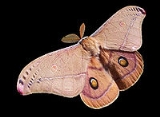
Moth
Overview
A moth is an insect
closely related to the butterfly
, both being of the order
Lepidoptera
. Moths form the majority of this order; there are thought to be 150,000 to 250,000 different species of moth (about ten times the number of species of butterfly), with thousands of species yet to be described. Most species of moth are nocturnal, but there are crepuscular
and diurnal
species.
Moths are not easily differentiated from butterflies
. Sometimes the name "Heterocera" is used for moths while the term "Rhopalocera" is used for butterflies to formalize the popular distinction; these, however, have no taxonomic validity.
Insect
Insects are a class of living creatures within the arthropods that have a chitinous exoskeleton, a three-part body , three pairs of jointed legs, compound eyes, and two antennae...
closely related to the butterfly
Butterfly
A butterfly is a mainly day-flying insect of the order Lepidoptera, which includes the butterflies and moths. Like other holometabolous insects, the butterfly's life cycle consists of four parts: egg, larva, pupa and adult. Most species are diurnal. Butterflies have large, often brightly coloured...
, both being of the order
Order (biology)
In scientific classification used in biology, the order is# a taxonomic rank used in the classification of organisms. Other well-known ranks are life, domain, kingdom, phylum, class, family, genus, and species, with order fitting in between class and family...
Lepidoptera
Lepidoptera
Lepidoptera is a large order of insects that includes moths and butterflies . It is one of the most widespread and widely recognizable insect orders in the world, encompassing moths and the three superfamilies of butterflies, skipper butterflies, and moth-butterflies...
. Moths form the majority of this order; there are thought to be 150,000 to 250,000 different species of moth (about ten times the number of species of butterfly), with thousands of species yet to be described. Most species of moth are nocturnal, but there are crepuscular
Crepuscular
Crepuscular animals are those that are active primarily during twilight, that is during dawn and dusk. The word is derived from the Latin word crepusculum, meaning "twilight." Crepuscular is, thus, in contrast with diurnal and nocturnal behavior. Crepuscular animals may also be active on a bright...
and diurnal
Diurnal animal
Diurnality is a plant or animal behavior characterized by activity during the day and sleeping at night.-In animals:Animals that are not diurnal might be nocturnal or crepuscular . Many animal species are diurnal, including many mammals, insects, reptiles and birds...
species.
Moths are not easily differentiated from butterflies
Differences between butterflies and moths
A common classification of the Lepidoptera involves their differentiation into butterflies and moths. Butterflies are a natural monophyletic group, often given the sub-order Rhopalocera, which includes Papilionoidea , Hesperiidae , and Hedylidae . In this taxonomic scheme moths belong to the...
. Sometimes the name "Heterocera" is used for moths while the term "Rhopalocera" is used for butterflies to formalize the popular distinction; these, however, have no taxonomic validity.
Unanswered Questions

